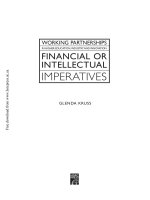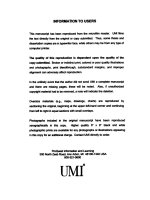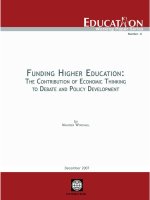Globalization in higher education: the evolution and trend.
Bạn đang xem bản rút gọn của tài liệu. Xem và tải ngay bản đầy đủ của tài liệu tại đây (1.19 MB, 9 trang )
<span class='text_page_counter'>(1)</span><div class='page_container' data-page=1>
<b>GLOBALIZATION IN HIGHER EDUCATION: </b>
<b>THE EVOLUTION AND TREND</b>
<b>Đào Thị Bích Thủy, Dr,</b>
<i>U n iv e rs ity o f E c o n o m ic s a n d B u s in e s s - V N U H a n o i, V ie tn a m</i>
<b>Abstract</b>
Higher education is said to be an essential foundation for personal, social and econom ic success in a
globalized economy. The 21st century is the age o f globalization. With dynamic processes of increasing
interdependence, growing competition, communication technologies and changing skill requirements in
the labor market, globalization has its impact on the life of higher education. The paper provides an
overall view on the evolution of and the trend in the globalization o f higher education. The first wave of
higher education globalization mostly meant the movements o f students across borders when students in
one country moving overseas for their university education. Over the past decades, the number of
international students enrolled outside their country of citizenship has risen dramatically, from 0.8 million
worldwide in 1975 to double at 1.7 million in 1995 and double again at 3.7 million in 2009 and this number
is forecasted to reach about 5.8 million by 2020. There is a clear tendency of international student
movement from developing to developed countries. Asia formed the largest group o f sending students to
overseas study, account fo r more than 50% o f the world mobile students and North America and Western
Europe is the predominant destination that receives international students, account for nearly 60% of the
world mobile students. The new wave of higher education globalization includes the movements of
teachers, programs and institutions across borders and has grown rapidly over the last decade. This form
enables students to take degree offered by a foreign university without leaving their home country.
International m obility in programs and institutions poses many opportunities and challenges to institutions
in developing countries as it creates both collaboration and competition between foreign and domestic
institutions. In one hand, international mobility of programs opens up many opportunities for collaboration
and development for higher education institutions in foreign developed and domestic developing
countries. The various forms of program mobility present the variety of models for collaboration between
foreign and dom estic institutions and bring ample benefits to both sides. In the other hand, international
institution mobility increases competition among foreign and domestic institutions since physical presence
o f foreign providers forces domestic providers to have more incentive for innovation and improvement of
their quality in courses, management and governance. The ever-growing demand fo r higher education in
developing countries plus the speed up of globalization in higher education opens a perspective for
collaboration and development between foreign and domestic institutions that help to build the countries’
domestic capacity to provide good quality higher education.
<b>K eyw ords: higher education globalization, modes of higher education collaboration, higher education in </b>
developing countries
</div>
<span class='text_page_counter'>(2)</span><div class='page_container' data-page=2>
The 21st century is the age o f globalization. Globalization means the increasingly global relationships of
culture, people and econom ic activity. With dynamic processes of increasing interdependence, growing
competition, communication technologies and changing skill requirements in the labor market,
globalization has its impact on the life of higher education. The globalization of higher education is
understood as “the process of integration or harmonization of world higher education systems,
knowledge, competencies and skills across national boundaries" (ishengoma, 2003).
Globalization in higher education arises for many reasons. Accelerating economic development in
developing countries requires more qualified knowledge workforce which raises a stronger need for
higher education. However, in those countries growing demand for higher education can not be met by
the domestic supply so m any people who wish to study are unable to secure a place at the domestic
universities. Cross-border higher education is a solution to the shortage of domestic supply as it serves to
bridge the gap between supply and demand in developing countries. Cross-border mobility is a means of
globalizing higher education. It has evolved from the traditional form o f international mobility in students to
a new wave o f international mobility of programs and institutions.
<b>The first w ave o f higher education globalization</b>
The first wave of higher education globalization mostly meant the movements of students across borders
when students in one country moving overseas for their university education. Over the past decades, the
number of international students enrolled outside their country of citizenship has risen dramatically, from
0.8 million worldwide in 1975 to double at 1.7 million in 1995 and double again at 3.7 million in 2009.
Especially since 2000, there has been a rapid increase in international mobile students at the average
annual rate o f 6,5%.
<i><b>Figure 1. Long-term trend in the num ber o f international students enrolled outside their country o f</b></i>
<i><b>citizenship (in millions)</b></i>
<i>Source: OECD and UNESCO Institute fo r Statistics.</i>
</div>
<span class='text_page_counter'>(3)</span><div class='page_container' data-page=3>
Europe with 26%. Students from Sub-Saharan Africa account for 7% and Latin America and the
Caribbean represent 6% of the total international students. Notably, East Asia and the Pacific take the
leading in sending students abroad, account fo r the largest share of the world mobile students. By
country, the top three countries who have the largest student demand fo r studying abroad are China,
India and South Korea with 15.2%, 5.8% and 3.71% o f the total international students respectively.
<i><b>Figure 2. Outbound mobile students b y region - 2009</b></i>
Where are the destinations foFinternational stũãOTts?_S tũ d ^ t^ 7 r â l^ t[T ẽ ir â ẽ c is io n s on w hicll cW ntry to
study based on various underlying factors. The OECD report on education (2011) gives out the four main
factors. First is the quality of programmes. International students increasingly select their study
destination based on the academic reputation of particular institutions or programmes, the recognition of
foreign degrees as perceived from a wide array of information on or rankings of higher education
programmes available in print and on line. Second is tuition fees and cost of living. Cost considerations
may play a role in choosing between similar educational opportunities, especially fo r students from
developing countries. Third is language of instruction. The language spoken and used in instruction is one
of major determinants in which country a student chooses to study. Countries whose language o f
instruction is widely spoken and read, such as English, French, German, Russian and Spanish can attract
a great number of students. The progressive adoption of English as a global language makes English-
speaking destinations being the dominance. Students may wish to improve their English language skills
through immersion in a native English-speaking context. Forth is immigration policy. Countries with eased
immigration policies can encourage inflow of international students and makes the countries more
attractive to them.
</div>
<span class='text_page_counter'>(4)</span><div class='page_container' data-page=4>
<i><b>Figure 3. Inbound o f mobile students by region - 2009</b></i>
South and West
Asia
<b>1</b>%
Sub-Saharan Africa
2%
Arab States
6
%
North America and
Western Europe
<b>59%</b>
Central and
Fastern Europe
<b>9%</b>
Central Asia
<b>1</b>
%
East Asia and the
Pacific
20
%
Latin America and
the Caribbean
<i><b>2%</b></i>
<i>Source: UNESCO Institute for Statistics, International H igher Education.</i>
By country, more than 77% o f international students have enrolled in institutions in countries belonging to
the Organization fo r Econom ic Co-operation and Development (OECD). In OECD countries the top five
countries are the United States, United Kingdom, Germany, France and Australia, which all together
account for nearly 46% o f total international students in OECD countries. In non-OECD countries, China,
Singapore and Malaysia are becoming the emerging contenders who have set ambitions to become
major exporters o f higher education (OECD and UNESCO statistics, 2011).
The trend o f international student mobility is expected to keep growing strongly in the future. Forecasts
done by the British Council, IDP Education Australia and Universities UK (2004) have showed that the
number o f students studying overseas can reach to 5.8 millions by 2020 or at the expected annual growth
rate o f more than 5%. Am ong regions, Asia continues to be the main source o f sending students which
account fo r 61 % of world mobile students in 2015 and increases to 65% by 2020.
<b>The new wave o f higher education globalization</b>
The new wave o f higher education globalization includes the movements of teachers, programs and
institutions across borders. This form enables students to take degree offered by a foreign university
without leaving their home country. International mobility of programs and institutions has grown rapidly
over the last decade (OECD, 2004).
</div>
<span class='text_page_counter'>(5)</span><div class='page_container' data-page=5>
<i><b>Table 1. Forecasts o f global and regional dem and fo r all international student places</b></i>
<b>World/ Region</b> <b>2015</b> <b>2020</b>
<b>Number</b>
<b>(000s)</b>
<b>Share (%)</b> <b>Number</b>
<b>(000s)</b>
<b>Share (%)</b>
<b>World</b> <b>4,384</b> <b>100</b> <b>5,815</b> <b>100</b>
<b>Africa</b> <b>409</b> <b>9.33</b> <b>525</b> <b>9.03</b>
<b>Sub-Saharan</b> <b>267</b> <b>6.09</b> <b>355</b> <b>6.1</b>
<b>North Africa</b> <b>142</b> <b>3.24</b> <b>170</b> <b>2.93</b>
<b>Middle East</b> <b>233</b> <b>5.31</b> <b>291</b> <b>5</b>
<b>Asia</b> <b>2,674</b> <b>61</b> <b>3,815</b> <b>65.61</b>
<b>East Asia</b> <b>1,666</b> <b>38</b> <b>2,485</b> <b>42.73</b>
<b>South East Asia</b> <b>373</b> <b>8.51</b> <b>489</b> <b>8.41</b>
<b>South Asia</b> <b>517</b> <b>11.79</b> <b>696</b> <b>11.97</b>
<b>Central Asian Republics</b> <b>119</b> <b>2.71</b> <b>145</b> <b>2.49</b>
<b>Americas</b> <b>247</b> <b>5.63</b> <b>285</b> <b>4.9</b>
<b>North</b> <b>112</b> <b>2.55</b> <b>125</b> <b>2.15</b>
<b>Central</b> <b>47</b> <b>1.07</b> <b>57</b> <b>0.98</b>
<b>South</b> <b>88</b> <b>2.01</b> <b>103</b> <b>1.77</b>
<b>Europe</b> <b>808</b> <b>18.43</b> <b>885</b> <b>15.22</b>
<b>West</b> <b>458</b> <b>10.45</b> <b>• </b> <b>482</b> <b>8.29</b>
<b>East</b> <b>350</b> <b>7.98</b> <b>403</b> <b>6.93</b>
<b>Oceania</b> <b>13</b> <b>0.3</b> <b>14</b> <b>0.24</b>
<i>Source: Vision 2020: Forecasting international student m obility a UK perspective (2004).</i>
<i>Franchise</i>
</div>
<span class='text_page_counter'>(6)</span><div class='page_container' data-page=6>
<i>Twinning</i>
In a twinning program, students are enrolled with a provider in foreign country and follow a foreign
program. They pursue part o f the program at the domestic institution and part in the partner foreign
institution. Only one qualification is awarded by the foreign institution. Arrangements fo r twinning
programs and awarding o f degrees usually comply with national regulations o f the provider in the source
foreign country. This cross-border education method usually requires the mobility o f both students and
programs. Students usually study in the domestic institution for one or tw o years and travel abroad to
complete their course in the foreign institution. Courses conducted in the domestic institution generally
use same teaching form ats, texts and evaluation methods as in the foreign campus, with some adaptation
for local content. Faculty o f foreign provider may also travel to domestic country fo r teaching some part of
the course along with local instructors. The local provider supplies physical facilities and recruits teachers
and staff, according to criteria and standards set by the foreign provider (Bashir, 2007).
<i>Double/joint degree</i>
Higher education providers in deferent countries collaborate to o ffe r programs which typically feature a
jointly developed and integrated curriculum and agreed-on credit recognition. Students usually study at
the two partnering higher education institutions. Upon completion o f the joint/double degree program,
students are awarded a single degree certificate issued and signed jointly by all institutions involved in the
program or separate degrees issued by each partner institution.
<i>The report on Joint and Double Degree Programs in the Global Context (2011) shows a growing number </i>
of universities around the world developing joint and double degree programs. The study is based on the
survey of major 245 higher education institutions from 28 different countries. It finds that joint and double
degree programs tend to be a relatively new mode o f academic collaboration but has now become an
increasingly important global trend as 95% of the responding institutions saying they plan to develop
more joint and double degree programs. Double degrees are much more common than joint degrees with
84% of the respondents offer double degrees, while 33% offer joint degrees. The most popular academic
discipline among the collaborative degree programs noted in this study is Business and Management,
followed by Engineering.
<i>Articulation</i>
Higher education providers in different countries permit students to gain credit for courses/programs
offered by all of the collaborating providers. This allows students to gain credit for work done with a
provider other than the provider awarding the qualification (Knight, 2006).
<i>Validation</i>
A foreign institution approves a domestic institution to develop a program which is equivalent to its own
and allows the dom estic institution to award the qualification of the foreign institution. The foreign
provider may assist the local provider to design and establish the course which it approves (Bashir,
2007).
<i>Virtual/distance</i>
A higher education provider delivers courses or a program to students in deferent countries through
distance and online modes. The students may get face-to-face support through the study or support
centres, study centres can be operated in collaboration with local providers in the host country (Knight,
2006).
</div>
<span class='text_page_counter'>(7)</span><div class='page_container' data-page=7>
For foreign institutions, partnership with local institutions enables them to broaden their education offers
and reach a greater number of students, studying fo r a degree awarded by a foreign developed country
institution is a dream for many people in developing countries as it will give them a better future carrier.
However, low average national income means not many of them can afford to study abroad because of
high tuition fees plus high overseas living cost. By providing courses in the domestic country, foreign
i n c t i t M t i f 'r 'c *"’í3n r»r*t '"'n !\/ h ị n h i n o n m o f i r n i in H n t pỊcsn ĨTÚHHỈỌ n r o u n f h n c o \A/Hr» ^ p p p ffrn rrl
i i i o U l u i i u i i o Í / C Ỉ Ỉ i Q u i C i w v I i v / t v / i i i y i i t y i i i i iV_>Ui I IV/ y i v J U p L / u i C i i o U l i i i U U i o 11 iV_/V_/i 11 Vj- y l u u j j l i l u o v VVi i w V-/C*i i u i i v i u
high tuition fees but not high living expenses incurred while studying abroad. And there is another group
of students, especially mature adult when money is not a matter for them but commitments to work and
fam ily are a m atter that restraint their ability to study abroad. This group of students is eager to take
foreign courses provided locally since they do not need to leave their home country.
Partnership with local institutions may reduce entrepreneurial risks to foreign institutions, such risks may
be associated with the unfamiliarity with culture, political system, law and regulations and the custom in
business practice. Beside they may offer high demand courses without much of infrastructure initial
investment since premises and facilities are provided by local partners, o th e r motivations for foreign
institutions to collaborate with domestic institutions are to strengthen their research collaboration,
advance internationalization, and raise international visibility/prestige. The overall consensus is that
international m obility o f programs is not of their lucrative nature, but rather to strengthen and broaden an
institution’s portfolio (Institute of International Education, 2011).
For domestic institutions, partnership with foreign institutions can add to their value as they have access
to skills in delivery, curriculum design, teaching resources and quality assurance and accreditation
systems. The quality o f human resource in local institutions also improves as their faculty can approach
and adopt modern modes of teaching and learning, have access to foreign institution resources such as
training network, workshop and e-library which strengthen their teaching skills and research capacity. All
of these can enhance educational quality and com petitiveness of local institutions which place them into a
higher national position. Beside, partnership with well accredited foreign institutions gains international
perspective for local institutions since the appearance of their name in the partnership list of well
internationally recognized institutions indicate their quality and potential for expansion. The prestige and
reputation of a foreign institution may assure the quality of institutions they partner with. Last but not least
is the chance fo r local institutions to broaden their market and reach a great number of students who wish
to study for a foreign awarded degree. Obviously, this group of students would not study in the local
institutions if these institutions did not partner with foreign ones to offer such courses to meet their
expectation.
The second type o f the new wave o f higher education globalization is international mobility of institutions.
International mobility o f institutions can be described as "the physical or virtual movement of an education
provider (institution, organization, company) across a national border to establish a presence in order to
offer education/training programs and/or services to students and other clients." (Knight, 2006). There are
different forms of cross-border provider mobility.
<i>Branch campus</i>
A higher education institution in foreign country establishes a satellite campus in the host domestic
country to deliver courses and programs to students in the host country. A branch campus is a subsidiary
o f the foreign institution. Students, upon successful completion o f the course program, are awarded a
degree from the foreign institution. In a few cases, branch campuses offer the opportunity fo r their
students to study at the home university for part of their program, and offer study abroad facilities for
students from the home campus (Altbach, 2011).
</div>
<span class='text_page_counter'>(8)</span><div class='page_container' data-page=8>
<i>Independent institution</i>
A foreign provider establishes in host domestic country a stand-alone higher education institution to offer
courses/programs and awards. Unlike branch campus, there is usually no “home institution” in the foreign
country and it is therefore independent (Knight, 2006).
<i>Virtual university</i>
A higher education provider in foreign country delivers credit courses and degree programs to students in
deferent countries through distance education, using predominantly the Internet technology mode and
generally without face-to-face support services for students (Knight, 2006).
International institution m obility is some kind of foreign direct investment when foreign education provider
establishes its physical presence in the host domestic country. It thus requires attention to national
regulations regarding status o f the entity, tax laws, repatriation o f earned income, boards of directors,
staffing, granting of qualifications, and selection of academic programs and courses. This type involves
greater entrepreneurial risk than international mobility of programs. Beside, international mobility in
institutions increases competition among foreign and dom estic institutions. Presence of foreign
institutions forces dom estic institutions to have more incentive for innovation and improvement o f their
quality in courses, managem ent and governance.
As can be seen, international mobility in programs and institutions poses many opportunities and
challenges to institutions in developing countries since it creates both collaboration and competition
between foreign and dom estic institutions. In one hand, international m obility o f programs opens up many
opportunities fo r collaboration and development for higher education institutions in foreign developed and
domestic developing countries. In the other hand, international institution mobility increases competition
among foreign and dom estic institutions. In both cases they help to build the country's domestic capacity
to provide good quality higher education which benefits students and thus the country.
At the national level, the new wave o f higher education globalization benefits the host countries in several
aspects. Economically, it helps to increase the GDP of the host country. The international mobility o f
programs and institutions means the production of education services taken place in the host country
which then adds up to the country level of GDP. Secondly, it lessens the pressure on domestic higher
education supply while providing more education opportunity fo r people that helps to build in even
stronger quality o f the labor force. W ithout international mobility of programs and institutions, only small
fraction of people who have high income can afford to study overseas. The presence of international
higher education at home can broaden the number of students as it reaches to the middle income group
who can afford to pay high tuition fees but not high living expenses overseas. As more people have
access to higher education, the percentage of work force with higher education level increases which
improves the quality of human resource in the country. It is well known that higher stock of human capital
increases labor productivity and is the driven force of economic growth. Thirdly, foreign investment in
education aids dom estic investm ent and release more domestic scarce resources fo r other development
activities. Finally, international mobility in programs and institutions may reduce the likelihood of “brain
drain", a situation refers to good educated people studying overseas decided not go back home.
</div>
<span class='text_page_counter'>(9)</span><div class='page_container' data-page=9>
<b>REFERENCES</b>
<i>1. Altbach, Phillip. The Branch Campus Bubble? 2011.</i>
2. Altbach, Phillip and Jane Knight. "The Internationalization o f Higher Education: Motivations and
<i>Realities". Education Journal o f Studies in International. 2011.</i>
<i>3. Armstrong, Lloyd. Multiple Views o f Globalization o f H igher Education and o f Place. 2011.</i>
<i>4. Bashir, Sajitah. Trend in International Trade in H igher Education: Im plications and Options for </i>
<i>Developing Countries. 2007.</i>
<i>5. Beine, Michel and Romain No'el. The Determinants o f International M obility o f Students. 2011.</i>
<i>6. Dirk Van Damme. H igher Education in the Age o f Globalization: The Need fo r a New Regulatory </i>
<i>Fram ework fo r Recognition, Quality Assurance and Accreditation. 2011.</i>
<i>7. Ishengoma, Johnson. The Myths and Realities o f H igher Education Globalization: a View from the </i>
<i>Southern Hemisphere. 2003.</i>
8. <i>Institute of International Education. Joint and Double Degree Programs in the Global Context: </i>
<i>Report on an International Survey. 2011.</i>
<i>9. Knight, Jane. H igher Education Crossing Borders: A Guide to the Implications o f the General </i>
<i>A greem ent on Trade in Services. A Report Prepared for the Commonwealth of Learning and </i>
UNESCO. 2006.
<i>10. Marginson, Simon and Marijk van der Wende. Globalization and H igher Education. 2006.</i>
<i>11. OECD. C ross-Border H igher Education and Development. 2008.</i>
<i>12. OECD. H igher Education to 2030. Volume 2: Globalization. 2009.</i>
<i>13. OECD indicators. Education at a Glance. 2011.</i>
<i>14. OECD. Internationalization o f H igher Education. 2004.</i>
<i>15. Pacific Rim Universities & Pacific Economic Cooperation Council. The Globalization o f Education: </i>
<i>The N ext Wave. Sagar, K. Globalization O f Education. 2005.</i>
<i>16. Verbik, Line. The International Branch Campus - Models and Trends. 2006.</i>
17. Vision 2020: Forecasting international student mobility a UK perspective 2004.
18. UNESCO statistics, 2011.
</div>
<!--links-->









